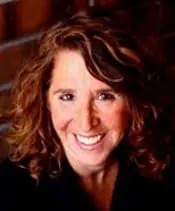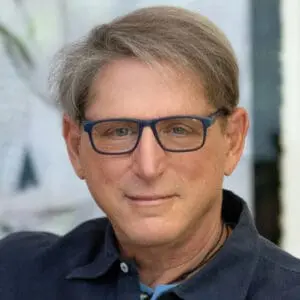In 1980, when I was a zealous young family therapist with a brand-new PhD and big hopes to contribute to the field, I met Rich at a family therapy conference and quickly realized we saw the field in similar ways. That instant connection turned into a deep friendship that lasted 40 years.
Over the years, Rich became such an important fixture in my life that parts of me haven’t caught up with the fact he’s gone. When something exciting—or funny or sad—happens, I still say to myself, “I can’t wait to tell Rich.” He was the male friend with whom I felt safe revealing my vulnerabilities. We supported each other through divorces and financial crises, all the while spending countless hours discussing our fascination with the nuances of therapy. He had a rare combination of high intellect and humor, warmth and sensitivity, combined with a passion to heal the world. In addition, we were basketball buddies and had intense one-on-one battles on courts all over the United States and Europe.
As he did with so many others in the field, Rich hugely assisted my career. Despite only later believing in the existence of parts per my Internal Family Systems (IFS) model, he helped me write my first article about IFS in 1987, and he deserved to be coauthor of the many subsequent ones that appeared in the Networker. In the early years, IFS was quite controversial and, more than anyone, Rich supported me whenever the blowback came in. Without his encouragement to carry on, I’m not sure I would have.
When we met as 30-year-olds, we’d talked about transforming the field of psychotherapy in the way that grandiose Young Turks do. And I’m amazed at how much Rich made those dreams come true. Not only did he find and follow exciting trends in the field: he actively created them. By showcasing innovative approaches that weren’t cerebral enough to be found in academic texts, Rich led psychotherapy to its heart. The stories he recruited and cultivated were always gripping, made you proud to be a therapist, and often conveyed something practical that you could try in your office. His interviews always went deep, and he challenged us to explain our ideas in ways that were down to earth.
In return, we were loyal—many of us spending months working for free with him on pieces for the magazine and presenting at our own expense at the conference each year. Certainly, we did it for our careers. But we also did it because we loved him and believed in the amazing community and vision he created. As his best friend, Fred Wistow, wrote in Rich’s obituary, “There was absolutely no one like him. And there never will be.”
Richard Schwartz, PhD, is the originator of the IFS therapy model and director of the IFS Institute.

“Tell stories, not theories. Talk about people, not cases.” These were some of the key messages I learned from my mentor, Rich Simon. He encouraged me to put my ideas about love and desire on paper. He made me write 11 versions of the article that eventually led to my first book, Mating in Captivity. He was a bon vivant, a showman who began every conference with a cabaret. He was social and loved to connect people to one another. And, as many now know, he struggled with bipolar disorder for much of his life. His suicide is a testament to the tenacious nature of mental illness and a reminder of the limitations of the mental health field.
I, along with many other of Rich’s mentees, dearly miss the man who made us. A few months ago, as we congregated to grieve—on Zoom, of course—I quickly learned something new about Rich. With his undivided attention, encouragement, and big heart, he made each and every one of us feel like his favorite child. It’s the kind of posthumous revelation that cracks the sadness open, makes me smile. We all thought we were special—because that’s how he made each of us feel. That’s true charisma.
Rooted in the master–apprentice relationship, mentorship is often thought of as a wholly professional experience. Great mentors delight in seeing you flourish. They’re not competitive. They bear witness to your transformation and growth. Rich saw things in me that I didn’t yet see in myself. He helped counteract the ever-present critical voice (my mother’s) that lived in my head and permeated my sense of self and well-being. He reflected a kinder and more capable version of myself than I could produce on my own. It made all the difference in my life.
The strongest protective factors against hardship are our relationships. We’re lost without the presence of truly benevolent, caring people—the teacher, coach, neighbor, or family friend who didn’t put us down, who shined a spotlight on parts of us that we didn’t know existed or didn’t value. Rich was one of those people for me. And though he had beautiful, strong relationships, and major resilience, I’ll always wish I could’ve done more for him, especially in the circumstances wrought by the pandemic.
For Rich’s community, the hole that he leaves is not just inside each of us but in the threads between us. Will we find a way to stay connected to each other without him? The answer, of course, is that we must. He was the master networker who never allowed us to forget that it’s our relationships that keep us tethered to ourselves and to each other.
Esther Perel, MA, LMFT, is an author, podcast host, and leader of the online clinical training platform Sessions with Esther Perel.

I’ve started this reflection to pay tribute to a legend in our field and my dear friend, Rich Simon, a hundred times. Often, the grief and loss felt too thick to navigate, and I had to stop writing. Even now, I can hear his warm, hectoring voice: “Okay, enough with the schmoozy intro. Your essay really starts on page four!” Like many, I’m a proud member of the Post-Simonized Trauma Survivors group. Membership is awarded when you get back your third draft of an article with more red ink then black, along with a summation like, “This is brilliant! We’re almost there!” Rich was a genius editor, and his insight and love of the craft made it worth going that extra mile, or five. I’d go just about anywhere for Rich. I felt loved and nurtured by him, both as a friend and a colleague.
Rich was hilarious and utterly irreverent, and many of the wild, heartwarming memories I have simply aren’t printable here. But other moments, snapshots, keep coming to mind:
Rich on the dance floor of the Symposium, his body seized by the ectoplasm of Mick Jagger in full, preening mode, delighting some late octogenarian at his side.
Rich flinging sweat all over the asphalt of a basketball court, killing Dick Schwartz, who’s not going down easy. I’m on the sidelines, cheering and warming up the defibrillation panels. “Clear!”
Rich at my wife’s 70th birthday gala, welcoming the crowd to “the greatest belated bat mitzvah on record.”
Rich appreciating this friend’s good looks on that particular day, or that one’s charm, or clarity, or scope. I called him—as I later found others did as well—The Great Appreciator.
Here’s what Rich did better than just about anyone I’ve ever met: he saw you. His eyes were sharp and his articulation specific. He saw you—uniquely, precisely—and he loved you for it. Intimacy, I believe, is the conjunction of truth and love. When I teach this principle in Relational Life Therapy, I say, “Have you ever been with someone who you felt knew you down to the ground and thought you were the greatest thing at the same time? You know that wonderful feeling?” Each time I say this, I think of Rich. He was, in this regard, one of the world’s great lovers.
Rich had it in him to be tart; one felt that his precision could cut deep if he wanted it to. But he was always kind. What a stunning combination—extraordinary perceptiveness matched with warmth and good will.
These days, I wake up around five to write. I make coffee. I open up my laptop. And I miss Rich Simon. “Aw man,” I think, “now there’s a sentence he would’ve liked.” I expect he’ll stay with me every day.
Terry Real, LICSW, is a bestselling author and the founder of The Relational Life Institute.

In April 1981, a letter arrived at the Philadelphia Child Guidance Clinic, then headed by Salvador Minuchin, from “Richard Simon, PhD.” The letterhead indicated he was from something called the Family Therapy Practice Network, Inc., and he was inviting me to write for the “Family Therapy Network Newsletter ($1.25),” which he described as a “publication attempting to improve the links among family therapists throughout the mid-Atlantic region.” And that is, indeed, what it did.
And then some.
At the time, family therapy was at the leading edge of a revolution in psychotherapy. Salvador Minuchin and other family systems leaders of the day were challenging the reigning orthodoxies of the dominant psychoanalytic model. And Rich—through his writing, persuasiveness, and limitless curiosity—reported this as if he were broadcasting from behind the therapy room’s one-way mirror, amplifying the voice of family therapy and sending it out into the larger world.
After I accepted the invitation to write for the Networker, the pages I’d labored over so lovingly and sent to Rich so confidently came back with entire paragraphs brutally redlined. When I called to indignantly complain about this destruction of my elegant prose, he waited patiently for me to finish ranting. In the pause that followed, I could sense, even over the phone, a smile forming on his lips, as he was considering how to parent a child whose precious crayon drawing clearly had to be scrubbed from the wall. “Jay, Jay,” said the Maestro, “there’s no such thing as writing—it’s all re-writing.”
But he was much more than an editor. To read his writing is to appreciate his singular place in our field’s shared history and to marvel at his ability to tell a story: one that felt like a fireside chat with a friend who possessed the uncanny ability to capture the compelling drama, the sheer juiciness of what therapists experience, day after day, case after case.
And God, was he funny, ready to poke fun at everything, especially himself. Throughout our friendship, I often traded good-humored barbs with him. When Rich reviewed the landmark Minuchin, Palazzoli, and Whitaker “Trialogue” Conference in Philadelphia in 1982, his opening paragraph focused on the conference being an “important step in family therapy’s journey into the cultural mainstream.” He then went on to add that it was, as far as he knew, “the first family therapy event to spawn its own T-shirt.” In mocking those shirts, he was mocking me because—I admit it—they were my idea. I laughed and loved him for it. Years later, when the Networker Symposium started giving away tote bags, I asked him, “What, no T-shirts?” He laughed just as hard.
When Rich’s favorite basketball player, Larry Bird, was in high school, he practiced 500 free throws every day before school. Rich was Bird’s editorial equal. No matter what he turned his attention to, he was doggedly persistent in going for the best. He’d go over a story and keep going until it had that whoosh feel of nothing but net. His persistence and drive was always for the benefit of the psychotherapy team—the tribe, as he liked to call us—and ultimately for the clients we serve.
Rich was our Paul Revere—and our Muhammad Ali, Tina Brown, and P. T. Barnum, all rolled into one. And in being all he was, he left a legacy that transformed both the profession and all of us who were blessed to know him. I’ll miss him for the rest of my days.
Jay Lappin, MSW, LCSW, is a senior faculty member at the Minuchin Center for the Family.

I first met Rich in 1995, when he came to my home in Lincoln, Nebraska, to interview me about my book Reviving Ophelia. I picked him up at the airport in my old, brown Honda. He was easy to spot at baggage claim, a sophisticated East Coast urbanite standing among families returning from Orlando, a local basketball team, and beefy Nebraskans in blue jeans and baseball caps.
Rich was staying at the Cornhusker. As we drove there, I told him that it was our ritziest hotel, right in the heart of the city. When I announced, “We’re just three blocks from the Cornhusker,” he replied, “I thought you said it was downtown!”
I told him, “Rich, we are downtown.”
That night, we met for dinner at the hotel’s restaurant, its floor-to-ceiling windows overlooking our state capitol. We talked for hours. The next morning, I planned to treat him to the prairie, where I always take my most treasured visitors. He seemed skeptical of the idea of a walk in nature, but good-naturedly agreed.
When I picked him up on the blustery winter morning, he was dressed in a stylish leather jacket and European-style loafers, while I, like any sensible Plains person, wore boots, a parka, and stocking cap. As we walked on Nine-Mile Prairie, we came across endless dry brown grasses, a frozen pond, milkweed pods, and bare cottonwoods. As I gushed about the subtle shades of gray on the hills and the occasional beautyberry or rose hips, Rich seemed baffled. Finally, he asked, “So where’s the main attraction?” When I swept my hand broadly across the horizon, he queried, “But what do you actually do out here?”
That night, my husband, Jim, picked up Rich and drove him to our place for dinner. We lived in an old stone house on a tree-lined street. Inside, our house was a hodgepodge of secondhand furniture, ancient towels, banged up pots and pans, and decades-old curtains. My cooking was not elegant; I probably made chili or pasta. Our three Siamese cats wove around Rich’s feet under our battered garage-sale dining table. We talked and listened to music far into the evening, and when we said goodnight, I knew we’d be friends for a long time to come.
That spring, my photo appeared on the cover of The Family Therapy Networker. “You’re our cover girl,” Rich joked. The picture had been taken on the prairie in January. I looked like I was dressed for a Siberian winter. Later, when I was a keynoter at the Symposium, he introduced me by joking about the thin, stiff, old towels at our house and our baffling (to him) walk in the prairie. He also made me sound like the best thing since sliced bread, and when he handed me a bouquet of roses, I remember saying, “I feel like Miss America.”
Rich and I had the most unlikely of friendships. He was a New York City Jewish boy from the Bronx, and I was a Methodist-raised Nebraska prairie girl turned Unitarian, then Buddhist. He liked sports, and I never voluntarily attended any ball games unless my kids were playing. Jim is a bluegrass and country musician, and I doubt Rich even knew who George Jones or Bill Monroe were.
We were also very much alike. We received our doctorates in the same year and were eager to unpack and learn from every new development in our field. We were both big conversationalists, who liked to discuss ideas and emotions and waste no time on small talk. We were both intensely loyal to our friends and depended on the energy of others to keep depression at bay.
Over the years, whenever Rich would call, he’d greet me by saying, “Hey kiddo, what’s happening?” If he were to call me today and ask his familiar question, I’d answer, “I’m missing you terribly, old friend, but I’m so grateful you were in my life.”
Mary Pipher, PhD, is the author of 10 books, including Reviving Ophelia and Women Rowing North.

Over almost four decades and throughout hundreds of conversations, the ideas for articles would emerge: the politics of mood, discovering our children, the new anxiety, the divided-self of teens, the millennial effect on psychotherapy—and, most relevant here, the craft of therapeutic conversation.
Conversations with Rich began like no other in my adult life: with an exchange of affectionate names like “Ronala” or “Richala,” or sometimes “Ronnie” or “Richie,” each evoking the better attachments of childhood. We both grew up in working-class New York City neighborhoods, and so our conversations were a stew of present and past—schoolyard buddies, neighborhood nebbishes, aspiring athletes. Somehow, each of us had stumbled into leading psychotherapy nonprofits, which required us to recognize the future of psychotherapy or doom ourselves to run museums honoring past orthodoxies. I’m not convinced Rich ever appreciated this as a “mission” any more than one understands one’s own breath. It simply came naturally to him—embracing a curious not-knowing, a beginner’s mind.
Whenever we talked, after an initial catching up on life events—our children and “existential fear and dread,” as we came to call it—we’d turn to the task at hand: exploring the latest challenge for psychotherapy. But conversations with Rich would always swerve into segues and somersaults and, inevitably, back to personal experiences. It was creativity as confessional, a shared enthusiasm and vulnerability. The ideas we discussed about our wider culture—its emerging effect on teens, parents, therapy—would trigger his own struggles and hopes, as well as mine, and sometimes ours together. Then, just when it’d start to feel dizzying, as if we were getting nowhere, a shape would emerge out of an amorphous piece of clay: an insight, an idea. That’s the true craft of conversation—and, like the hand of a caring friend or partner or parent, it felt steadying, healing.
When I was 23, I had a dream a month after my father suddenly died. In it, he approached me holding a piece of clay and said, with a flicker of light in his eyes, “Here, Ronnie, you can do this, too,” touching my face as he slowly disappeared. I woke up sobbing. The next day, I bought some clay and began to sculpt, a skill I never knew I had.
In a way, I think Rich gave all of us a piece of clay—a conversational space through which to express our unique passions and shared humanity, our enthusiasm and deep vulnerability. I’ll carry this gift with me forever, and I hope every therapist, in their mission to heal, can carry it with them, too.
Ron Taffel, PhD, is the chair of the Institute for Contemporary Psychotherapy in NYC and the author of many books and articles on therapy and family life.

I’ll go out on a limb here: Rich Simon was one of the greatest clinicians of our time. True, he didn’t spend much of his career seeing clients. But he was an extraordinary clinical coach to anyone aiming to practice psychotherapy with skill, imagination, and compassion.
I met him 40 years ago at an American Marriage and Family Therapy conference in Dallas. Along with a few other, likeminded souls, we banded together as the new kids on the block, young clinicians who wanted to learn to be the best we could be for our clients. In short order, we became a peer consultation group and an ad hoc family.
Later, when I started writing for the magazine and presenting at Symposium, Rich never failed to inquire about my clinical work, and I had the great fortune to encounter his clinical guidance directly. When I’d give him a summary of a particularly interesting case, he’d always want to go deeper: “How are you approaching it? What made you choose that direction? How are you feeling about it? What kind of change are you hoping for? Would you do anything different?” He seemed most interested in what was going on inside of me and the impact that had on the client.
Often, he’d challenge me, and occasionally we fought. Once, when I was writing an article on ethics and feeling hesitant about talking about a crush on a client I’d wrestled with at one point, he asked me point blank, “How the hell can you expect to help anyone else face their ethical dilemmas if you can’t be open about yours?”
Whether or not you knew Rich personally, I’d hazard a guess that he coached you, too. Through his work outside the therapy room, he encouraged all of us to look at our cases through new lenses and dip our toes into a variety of interventions and models. His example showed us what we can accomplish when we band together and generously support one another. We need each other: Rich knew this. The impact is hard to calculate, but via the clinical trickle-down effect, I’d guess that Rich has exponentially helped to heal millions of souls. His memory is a magnificent blessing.
Mary Jo Barrett, MSW, is the founder and director of the Center for Contextual Change.
Esther Perel
Psychotherapist and New York Times bestselling author Esther Perel is recognized as one of today’s most insightful and original voices on modern relationships. Fluent in nine languages, she helms a therapy practice in New York City and serves as an organizational consultant for Fortune 500 companies around the world. Her celebrated TED talks have garnered more than 40 million views and her international bestseller Mating in Captivity: Unlocking Erotic Intelligence became a global phenomenon translated into more than 30 languages. Her newest book is the New York Times bestseller The State of Affairs: Rethinking Infidelity (HarperCollins). She is a Licensed Marriage and Family Therapist, an AASECT certified sex therapist, a member of the American Family Therapy Academy and of the Society for Sex Therapy and Research. Esther is also the host of the hit podcast “Where Should We Begin?” which is available on Apple Podcasts. Her latest project is “Where Should We Begin – A Game of Stories with Esther Perel.” Learn more at EstherPerel.com.
Jay Lappin
For more than forty years, Jay Lappin, MSW, LCSW, has been helping families, couples and individuals navigate life’s transitions to create strong, sustainable relationships. Trained in the relational architecture of Structural Family Therapy by Dr. Salvador Minuchin, he has worked with, written and taught professionals and the public how to become empathic and effective problem solvers. Jay’s work on family therapy, couples therapy, diversity and large systems of care has been published in professional journals and texts and he has been quoted in popular magazines and newspapers such as Cosmopolitan, Self, USA Today, The Philadelphia Inquirer, and The Courier–Post. He’s a former Contributing Editor for the Psychotherapy Networker.
Mary Jo Barrett
Mary Jo Barrett, MSW, is the founder and director of Contextual Change and coauthor of Treating Complex Trauma: A Relational Blueprint for Collaboration and Change and The Systemic Treatment of Incest.
Mary Pipher
Mary Pipher, PhD, is a clinical psychologist, author, and climate activist. She’s a contributing writer for The New York Times and the author of 12 books, including Reviving Ophelia, Women Rowing North, and her latest, A Life in Light. Four of her books have been New York Times bestsellers. She’s received two American Psychological Association Presidential Citation awards, one of which she returned to protest psychologists’ involvement in enhanced interrogations at Guantanamo.
Richard Schwartz
Richard C. Schwartz, PhD, began his career as a systemic family therapist and an academic. Grounded in systems thinking, Dr. Schwartz developed Internal Family Systems (IFS) therapy in response to clients’ descriptions of various internal parts. He focused on the relationships among these parts and noticed systemic patterns across clients. When their parts felt safe and could relax, his clients would spontaneously feel confident, open, and compassionate. Dr. Schwartz dubbed this state the Self and discovered that clients knew how to heal their parts when they were in Self. Dr. Schwartz is often a featured speaker for national professional organizations. He has published over fifty articles and many books about IFS. Website: https://ifs-institute.com
Ron Taffel
Ron Taffel, PhD, is Chair, Institute for Contemporary Psychotherapy in NYC, the author of eight books and over 100 articles on therapy and family life.
Terry Real
Terry Real, LICSW, is an internationally recognized couples therapist, speaker, author, and founder of the Relational Life Institute (RLI). His latest bestseller is Us: How to Get Past You and Me to Build a More Loving Relationship. He’s also the author of I Don’t Want to Talk About It: Overcoming the Secret Legacy of Male Depression (Scribner), the straight-talking How Can I Get Through to You? Reconnecting Men and Women, and The New Rules of Marriage: What You Need to Make Love Work.























